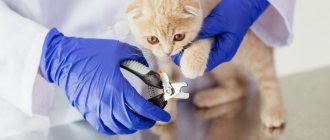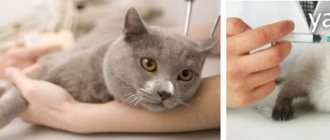4966Administration
1
Can cats have sweets? Many owners wonder when they see their pet eagerly gobbling up the cake, chocolate or ice cream they were treated to. It’s worth noting right away that cats do not feel the taste of sweets, since there are no receptors on their tongues that detect such a taste. The animal also lacks a number of enzymes that ensure the digestion of sugars, which is why they only harm their health. Owners need to remember exactly that cats are not allowed sweets.
What attracts an animal to something sweet is not the taste, but the smell or texture. Regarding the ice cream that they are treated to in the hot weather, everything is quite simple - pets do not need its sweetness, but cold. Also, the cat may like the oils included in the sweets. Thus, it is clear why a cat, in principle, cannot love sweets and it is not sugar that is attractive to her.
© shutterstock
Why can't cats have sweets?
Can cats have sweets? Many owners wonder when they see their pet eagerly gobbling up the cake, chocolate or ice cream they were treated to.
It’s worth noting right away that cats do not feel the taste of sweets, since there are no receptors on their tongues that detect such a taste. The animal also lacks a number of enzymes that ensure the digestion of sugars, which is why they only harm their health. Owners need to remember exactly that cats are not allowed sweets. What attracts an animal to something sweet is not the taste, but the smell or texture. Regarding the ice cream that they are treated to in the hot weather, everything is quite simple - pets do not need its sweetness, but cold. Also, the cat may like the oils included in the sweets. Thus, it is clear why a cat, in principle, cannot love sweets and it is not sugar that is attractive to her.
What to do if your cat ate chocolate?
- First, try to estimate how much chocolate your pet has eaten.
- Check the composition of the chocolate and watch the cat.
- Try getting him to drink more water.
- If you notice any alarming symptoms, take him to the vet and be sure to tell him what and how much your cat ate.
It's true that a cat would have to eat an entire bar of high-contaminant chocolate to be considered mortal. So can cats eat chocolate? Absolutely not! Even small doses of this product harm the digestive system, heart and brain. They also dehydrate the cat, which is especially dangerous.
When does a cat need sugar?
In rare cases, a cat needs sugar as medicine. This phenomenon occurs during the recovery period of an animal after a serious illness, when it is exhausted and there is a reduced level of sugar in its blood compared to what it should be normally. However, sweet medicine can only be used as prescribed by a veterinarian. The cat owner himself should not prescribe such therapy.
In this situation, the cat is given a glucose solution or regular sweetened water. During such treatment, strict monitoring of the animal’s condition is required in order to promptly stop the supply of sweets. Even during treatment, the following sweets are prohibited for the animal :
- confectionery;
- sweet dairy products;
- chocolate;
- sweet carbonated drinks (some cats readily drink them).
In order not to harm your pet, you must strictly follow all the veterinarian’s recommendations. If the cat is not ready to drink sweetened water, it may be forced to drink it. It is also not uncommon to resort to the simplest method and give the pet IVs with glucose, which can be not only intravenous, but also subcutaneous.
You cannot uncontrollably use sweet therapy for a cat, even when she is old and she always gets better after it. A loving owner should know how to properly support an animal, and therefore older cats need to be managed by a veterinarian.
How sugar can harm you
All sugar-containing treats pose a serious danger to cats of all ages, but pregnant and lactating females, small kittens and older cats are most affected. With prolonged consumption of foods containing sugar, even the healthiest animals can develop diseases.
Gastrointestinal disorders
An excess of sweets can cause stool disorders (diarrhea or constipation), gastritis, various types of colitis, and even inflammation of the pancreas. These troubles take a long time to treat, it is difficult, and the animal will have to be on a strict diet.
Development of diabetes
When a cat eats sweets, even in small quantities, the pancreas gets severe overload. If this happens regularly, inflammation develops, leading to organ destruction. Insulin production stops and the cat’s blood sugar rises. By the way, sweeteners (for example, xylitol), added by manufacturers to sweeten foods, also contribute to the development of diabetes. Without maintenance therapy, the life of a diabetic cat is shortened.
Harm to the kidneys and liver
If a cat loves sweets, the risk of urolithiasis increases - the load on the kidneys increases, the acid-base balance is disrupted. KSD causes frequent painful urination and sometimes requires surgical intervention.
Irreversible changes occur in the liver - working tissues are replaced by useless fatty layers. This means that the organ will not be able to remove toxins and waste products as well as before.
Weakening of the immune system
When sugar enters the intestines, the number of protective cells decreases many times, which has a bad effect on the animal’s immunity. The cat becomes unstable to bacterial and viral attacks, even if it is vaccinated. In severe cases, disruptions occur in the endocrine system.
Fat deposits
Pets do not use as much energy as outdoor pets. As a result, fat deposits accumulate, both subcutaneous and internal. The latter envelop the organs, as a result their performance decreases.
Obesity leads to a lot of health problems: from diseases of internal organs to arthritis and arthrosis.
Diseases of the teeth and oral cavity
The cause of microcracks in tooth enamel is sweetened food. It also provokes the appearance of caries, tartar, bleeding gums, and tooth loss. The main problem is that sugars wash out calcium in the body, which has a bad effect on the condition of teeth and bones. And treating dental problems in animals is complex, difficult and very expensive.
Allergy
The liver and pancreas process and utilize carbohydrates in the body. If an animal consumes a lot of harmful treats, these organs do not have time to process sugar and, as a result, a lot of glycogen accumulates in reserve. At one point, the body begins to react to excess carbohydrates as an allergen. So if your cat starts itching or has discharge from her eyes, immediately stop giving her harmful treats.
How can sweets harm cats?
A cat gets a lot of harm from eating sweets. For this reason, a loving owner will never test the animal’s strength and feed it sweets, justifying himself by saying that the cat loves sweets.
Also, sometimes animal owners find the following excuse for improper feeding: “If the cat eats sweets, it means that she lacks something that is contained in it.” Alas, such excuses are only needed so as not to scold yourself for the fact that the cat became seriously ill and, as a result, her eyelids were significantly reduced.
Hot and not sweet ice cream
In hot weather, ice cream is, on the one hand, useful for a cat, as it helps its body cool down, but on the other hand, due to the sugar, it causes significant harm to it. In order for the cat to receive only the benefits of the product, you need to prepare ice cream for it yourself, simply freezing cream or milk churned with butter.
Sweets and cats are not compatible, and you should not look for an excuse for your unreasonable behavior when an animal is given something that only harms its health. Sweet tastes are of no interest to cats.
Symptoms of chocolate poisoning
The lethal amount of theobromine for a cat is 200 mg.
A cat weighing 4.5 kg will be seriously harmed if she eats:
For kittens, the indicated portions are reduced according to body weight.
Signs of poisoning:
- excited, nervous state;
- lethargy;
- dehydration;
- excessive urination;
- heart rhythm disturbance;
- convulsive and convulsive states;
- nausea, urge to vomit;
- diarrhea;
- rapid breathing;
- increased blood pressure.
In case of serious poisoning and lack of veterinary care, the animal falls into a coma and dies.
If the cat is taken to the veterinarian within an hour from the moment of poisoning, and the chocolate has not yet had time to be absorbed, then the specialist rinses the stomach and gives the tailed patient activated charcoal.
If more than an hour has passed, the pet remains in a hospital setting and is connected to a ventilator and heart rate monitoring. The animal's urine and blood are taken for analysis to confirm intoxication.
This treat is an extremely harmful product for cats. Owners should not risk the health and life of their pets. The most common consequence is diabetes, but the animal can also develop pancreatitis due to fats and sugar. A severe case can result in death.
Rating Author of the article Elena Datsyuk Pastry chef Articles written 432
A cat (due to its physiology) is not able to recognize sweet taste. This is the first thing you need to start from when looking for an answer to the question “can cats have sweets?”
When does a cat need sugar?
Cats do not have receptors that allow them to sense sweet taste. Unlike dogs, they are 100% carnivores, whose digestive system is designed to digest protein foods with a small addition of carbohydrates.
In the wild, having caught a mouse, a cat, eating the entrails of a vole, will receive a small amount of grain and grass located in the stomach of the trophy, but this amount is extremely small and is partially processed by the juices of the rodent.
Sometimes the cat eats grass itself, wanting to cleanse the gastrointestinal tract of fur. An animal that eats ice cream, chocolate, or cookies does not feel the sweet taste; it is attracted to milk protein, fats, and amino acids. Cats don't need sugar. Carbohydrates are necessary for a balanced diet, but “good”, slow: rice, buckwheat, vegetables, fruits.
The exception is the recovery period after an illness, when the body is exhausted and the blood sugar level is below normal. On the recommendation of a veterinarian, the mustachioed patient is given sweet water and glucose, periodically undergoing tests to ensure timely cessation of therapy.
Confectionery and sweet drinks are not allowed. Diabetic human products containing xylitol and similar substitutes cause severe poisoning. It is possible to administer glucose through droppers or subcutaneous injections.
Deny or allow?
The main reason why cats cannot eat sweets is the presence of sugar in treats. As the famous saying goes, sugar is sweet poison, and for cats it works one hundred percent.
Is it possible to give cats sweets at least in small quantities? This is a question that each owner answers for himself, based on many factors: the recommendations of the veterinarian, the general health of the pet, its character and personal relationship with it. After all, everyone knows that cats remember refusals, get offended, and the most characteristic ones can even take revenge.
It often happens that the animal begs for sweets. In this case, veterinarians recommend giving your pet a microdose of treats. It is unlikely that anything terrible will happen to him from a drop of condensed milk or yogurt. The main thing is to do it in doses, preferably as encouragement.
Another way to limit sweets is to outwit your pet by switching his attention to a healthy treat designed with all his needs in mind. Now there is a huge selection of such “desserts” for cats. They are available not only in different flavors, but also in a wide variety of formats and textures: straws, cream, fillets, purees, rolls, etc.
If you suddenly haven’t taken care of your furry friend and he has eaten too much condensed milk, chocolate, cookies or ice cream, it is important to take him to the veterinarian for an examination, donate blood and monitor his blood glucose levels. This will help prevent dangerous diseases.
Is it possible to give sweets to cats?
Of course, a cat won’t die from one cookie, but why give your pet something that harms it? Fast carbohydrates contribute to changes in eating behavior: they instantly fill you up and dull the feeling of hunger for a short period. Sugar is quickly absorbed and hunger returns.
Excess calories become fat. Excess body weight creates unjustified additional stress on the heart, lungs, joints, and circulatory system, and hormonal balance is disrupted.
It is especially harmful to give chocolate to cats. Caffeine excites the central nervous system, increases blood pressure, makes the heart beat faster, and provokes muscle tremors. Large amounts of theobromine, which is found in all types of chocolate, can cause the death of an animal.
Cats that regularly consume illegal sweets suffer from:
- diabetes mellitus;
- blindness;
- fungal diseases;
- conjunctivitis;
- allergies, dermatitis;
- low immune defense;
- kidney and liver diseases;
- pathologies of the nervous, cardiovascular, and digestive systems.
Eating sugar can cause infertility in a cat, complicate the course of pregnancy, lead to the birth of still babies, and threaten premature aging.
How harmful is chocolate?
This depends on several factors.
- First of all, it depends on the type of chocolate. The most dangerous is dark chocolate, because it contains the largest amount of toxic substances. Only cocoa powder is more dangerous than chocolate.
- Our pet's age, weight and general health are also important. The degree of toxicity is also affected by the type of cocoa, its ripeness at harvest, and even the processing method.
- White and milk chocolate are the least harmful.
Symptoms appear after consuming about 20 mg theobromine/kg body weight. After approximately 40 mg/kg body weight, there is a high chance of damage to the cat's heart, and even 100 mg/kg is a potentially lethal dose for it. The average bitters bar contains about 1,400 mg of theobromine. These amounts may vary from source to source, but they all agree on one thing: even the smallest amount of chocolate has a negative effect on a cat's body.
In what form can a cat eat sweets?
Nature has not endowed the cat’s body with the ability to synthesize insulin, which breaks down sugar; large amounts of glucose are simply not absorbed. Therefore, all confectionery products, sweet yoghurts, and drinks are prohibited to those with a mustache, even if they express a desire to treat themselves.
This happens in the case of vitamin deficiency, the desire to get food from the owner’s hands, sympathy for a certain consistency of food, or a tempting aroma.
You can offer your cat a healthy alternative - apple, plum, pear, apricot, blueberries, raspberries, strawberries. Many people like honey, but the product is a strong allergen; it is necessary to introduce it into the diet in small doses, monitoring the body’s reaction.
Dry and fresh fruits do not force the cat to eat if he doesn’t want to. Wanting to give your pet a cooling treat, they freeze natural milk. Cats happily eat this homemade ice cream; the lack of sugar in it does not bother the animals.
Can cats have sweets?
Can cats have sweets: can cats taste sweets and why they can’t have sweets.
Sweets are of no interest to cats. Unlike even dogs, cats love only one thing - meat (as well as sleep and play). And this is not at all because they are super-predators who are eager to kill, but because, unlike other mammals studied, they simply do not taste sweetness.
On the surface of the tongue of most mammals there are taste receptors, the proteins of which bind to food entering the mouth, recognize its type, and send this information to the brain. For example, in humans, there are five types of taste buds that respond to salty, sour, bitter, sweet and umami (meat). The receptor responsible for sweetness consists of two proteins created by two separate genes - Tas1r2 and Tas1r3. Any sweetness is, first of all, carbohydrates - an important source of energy for herbivores and omnivores, like humans. Cats are exclusively carnivores, so they have never had the need to distinguish carbohydrates, which is why they lack the corresponding taste receptor (or, on the contrary, they do not eat carbohydrate foods due to the absence of this receptor).
In 2005, the Monell Chemical Senses research center in Philadelphia discovered that all felids (not just domestic cats, but also tigers, lions and others) are missing 247 base pairs of amino acids that make up the DNA of the Tas1r2 gene. As a result, it is not able to create the necessary protein, which is why cats do not feel the sweet taste and do not eat sweets.
Why does a cat eat sweets?
There are many examples that some cats love sweets - they eat ice cream, chocolate or candy. The reason for this has not yet been determined, but perhaps a single protein created by the Tas1r3 gene allows them to somehow sense high concentrations of sugar. There are also several other explanations for this strange behavior:
- a cat may be attracted not by taste, but by smell; - it is possible that she wants some kind of sweetness because she feels the presence of salt, fats or some amino acids in it; — perhaps your cat just likes the texture of certain sweet foods











